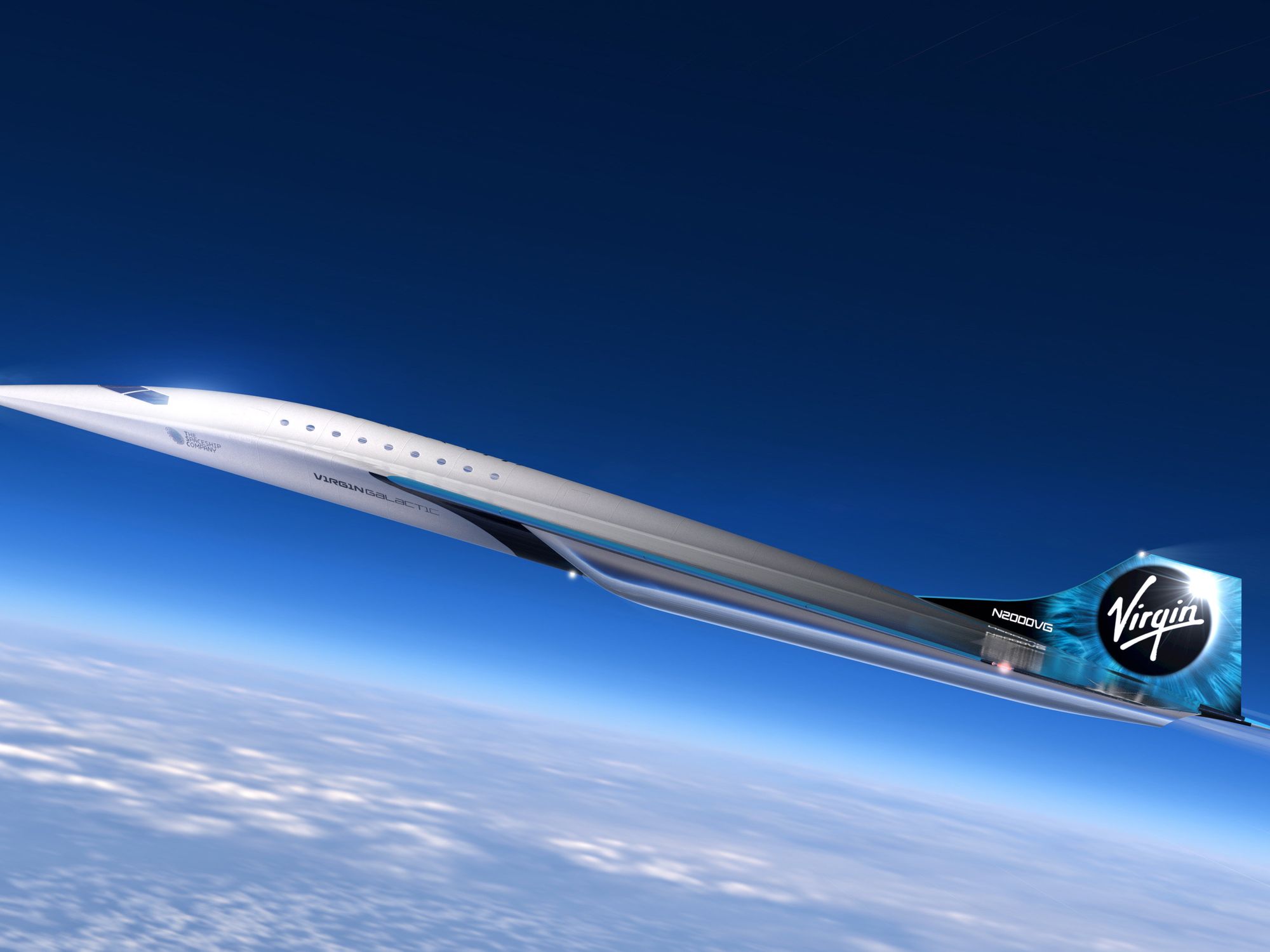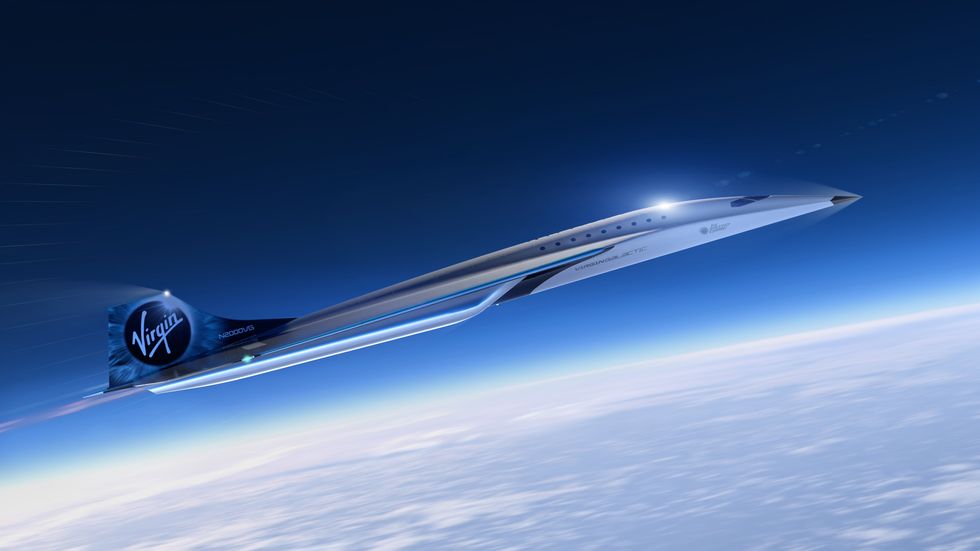Virgin Galactic's Offers First Look at its Supersonic Airplane Concept
GeekWire contributing editor Alan Boyle is an award-winning science writer and veteran space reporter. Formerly of NBCNews.com, he is the author of "The Case for Pluto: How a Little Planet Made a Big Difference." Follow him via CosmicLog.com, on Twitter @b0yle, and on Facebook and MeWe.

Virgin Galactic has taken the wraps off a concept for an airplane capable of flying three times the speed of sound, to be developed with support from Boeing and Rolls-Royce.
The project would be distinct from Virgin Galactic's SpaceShipTwo suborbital space plane program, which is closing in on the start of commercial operations at Spaceport America in New Mexico.
Today's announcement follows through on the company's heightened focus on high-speed aircraft development, which is backed by a $20 million investment from Boeing HorizonX and supported by a deal with NASA to collaborate on supersonic projects.
Such an initiative seems likely to pit Virgin Galactic against aerospace industry players that have a head start in the race to revive supersonic travel — ranging from SpaceX and Lockheed Martin to Boom Supersonic, a startup that Virgin Galactic partnered with years ago.
Virgin Galactic says it has signed a non-binding memorandum of understanding with Rolls-Royce for the development of the plane's engine propulsion system, has put the design through a mission concept review in cooperation with NASA representatives, and is working with the Federal Aviation Administration to lay out a certification framework for the plane.
George Whitesides, who recently transitioned from CEO to a new position known as chief space officer to work on new projects, said the company has made "great progress so far" on the concept.

"We are excited to complete the mission concept review and unveil this initial design concept of a high-speed aircraft, which we envision as blending safe and reliable commercial travel with an unrivaled customer experience," Whitesides said in a news release.
The basic parameters of the design call for a Mach 3 delta-wing aircraft that would have the capacity to fly nine to 19 people at an altitude above 60,000 feet. Virgin Galactic could provide customized cabin layouts to address customer needs, including business-class or first-class seating.
The plane would be designed to use existing airport infrastructure and lead the way in the use of sustainable aviation fuel.
The company provided no timetable for development. Nevertheless, the stock market's initial reaction to the news was positive — boosting Virgin Galactic's share price in early trading today.
Commercial supersonic travel faded away in 2003 with the retirement of the British-French Concorde, due to concerns about cost and sonic-boom restrictions. In recent years, NASA and a variety of aerospace ventures have been looking into "quiet-boom" technologies that might make supersonic flight more palatable (and satisfy regulators).
NASA has partnered with Lockheed Martin to build a test aircraft known as the X-59 QueSST, or Low-Boom Flight Demonstrator. The X-59's first flight is due in the 2021-2022 time frame.

Meanwhile, Aerion Supersonic, Boom Supersonic and Spike Aerospace are among a new crop of supersonic startups hoping to field planes and win FAA certification in the years ahead.
Back in 2016, Virgin Galactic founder Richard Branson said his company would assist Boom with engineering, design, manufacturing, flight testing and operations — and would take a purchase option on the first 10 airframes. Today's announcement suggests that Virgin Galactic is now moving in a different direction.
For what it's worth, Boom is due to roll out its prototype XB-1 supersonic jet in October.
Some wondered whether Virgin Galactic will be arriving too late to the supersonic soiree, or whether its plans for a high-speed aircraft were sufficiently realistic.
"Had to recheck the date on the calendar. Nope, not April 1," Aviation Week's Steve Trimble tweeted.
Mars Society President Robert Zubrin, meanwhile, tweeted an illustration showing SpaceX's planned Starship super-rocket and wrote, "Mach 3 won't cut it. The competition will be doing Mach 25."
If Virgin Galactic's supersonic airplane turns out to be vaporware, at least it's cool-looking vaporware.

This story first appeared on GeekWire.
- Virgin Galactic's Offers First Look at its Supersonic Airplane Concept ... ›
- Virgin Galactic Strikes Deal With NASA to Work on Supersonic ... ›
- SpaceX to Launch Four Civilians into Orbit this Year - dot.LA ›
- Virgin Galactic's Space Flights Grounded Amid Investigation - dot.LA ›
- Virgin Galactic Flight Went Off Course While Landing: FAA - dot.LA ›
- Skyryse’s FlightOS Gives Pilots Control With Just a Tablet - dot.LA ›
GeekWire contributing editor Alan Boyle is an award-winning science writer and veteran space reporter. Formerly of NBCNews.com, he is the author of "The Case for Pluto: How a Little Planet Made a Big Difference." Follow him via CosmicLog.com, on Twitter @b0yle, and on Facebook and MeWe.




